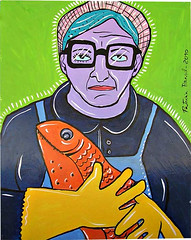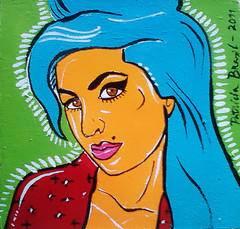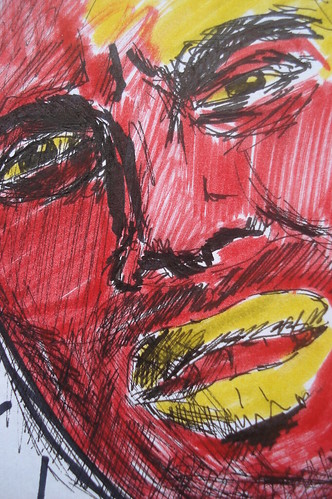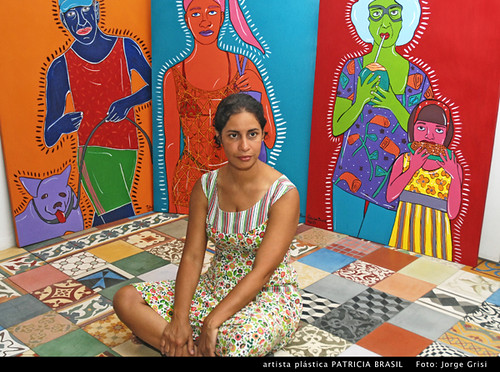
Patrícia Brasil at her studio - © Jorge Grisi
Colorful and sensitive painter Patrícia Brasil talks about her life in Rio de Janeiro, her artistic work, her sources of inspiration and her link to JKPP group.
Zoraida de Torres: ¿Podrías presentarte brevemente para quienes aún no te conocen? Could you please introduce briefly yourself?
Patrícia Brasil: Sou brasileira, nascida em 1965 na cidade Rio de Janeiro. Sempre fui incentivada por minha família a olhar. Lembro que meu pai me levava para ver o Desfile de Escolas de Samba desde que tinha oito anos. Ficava acordada a noite toda vendo aquele espetáculo de cores. Percebi, desde cedo, que a arte liberta. - Soy brasileña, nacida en 1965 en Río de Janeiro. Mi familia siempre me alentó a mirar. Recuerdo que mi padre me llevaba a ver el Desfile de Escuelas de Samba desde que tenía ocho años. Estaba toda la noche despierta, viendo aquel espectáculo de colores. Desde muy pronto me di cuenta de que el arte libera. - I am Brazilian, born in 1965 in Rio de Janeiro city. I was always encouraged by my family to look. I remember my father taking me to see the Samba Schools Parade since I was eight years old. I stayed up all night watching that show of colors. I realized early that art liberates us.
Z: ¿Cuál es tu formación artística? Which is your artistic training?P: Nos anos 80 estudei Belas Artes / Gravura na Universidade Federal do Rio de Janeiro e arquitetura em uma faculdade particular. Meu primeiro emprego foi como Pintora de Arte em uma emissora de televisão, reproduzindo quadros e painéis cenográficos. Nos anos 90 migrei para Artes Gráficas onde até hoje atuo como diretora de arte. - En los años 80 estudié Bellas Artes / Grabado en la Universidad Federal de Río de Janeiro y Arquitectura en una universidad privada. Mi primer empleo fue de pintora en una cadena de televisión, reproduciendo cuadros y paneles escénicos. En los años 90 me pasé a las artes gráficas, donde he trabajado hasta hoy como directora de arte. - In the eighties I studied Fine Arts / Printmaking at the Federal University of Rio de Janeiro and architecture at a private college. My first job was as a painter at a television station, reproducing paintings and scenic panels. In the nineties I migrate to Graphic Arts, where I've been working until now as an art director.
Z: ¿Qué estilos y qué artistas te gustan o te inspiran? Which are the artists and styles that you like or that inspire you?
P: Há pouco ouvia a cantora/compositora, Adriana Calcanhoto, na uma música, "Esquadros", que diz: "Eu ando pelo mundo / Prestando atenção em cores / Que eu não sei o nome / Cores de Almodóvar / Cores de Frida Kahlo / Cores! / Passeio pelo escuro / Eu presto muita atenção / No que meu irmão ouve..." Presto muito atenção em tudo. Faço questão de ser conectada para ter uma janela para o mundo. Mas olho principalmente para meu entorno, minha gente, minha cultura. Tenho Heitor dos Prazeres e Tarsila do Amaral como ícones. - Hace poco escuchaba a la cantante/compositora Adriana Calcanhoto, que en su canción "Esquadros" dice: "Me paseo por el mundo / Fijándome en colores / de los que ignoro el nombre / Colores de Almodóvar / Colores de Frida Kahlo / ¡Colores! / Viajo por lo oscuro / y presto mucha atención / a lo que oye mi hermano..." Presto mucha atención a todo. Intento estar conectada para tener una ventana al mundo. Pero miro principalmente a mi entorno, mi gente, mi cultura. Tengo como iconos a artistas como Heitor dos Prazeres y Tarsila do Amaral. - I was just listening the singer/songwriter Adriana Calcanhoto, who says in her song "Esquadros": "I walk through the world / Watching Colors / whose name I don't know / Almodóvar's colors / Frida Kahlo's colors / Colors! / I travel on the dark / I pay close attention / to what my brother listens..." I pay close attention at all. I must be connected to have a window to the world. But I look mainly for my surroundings, my people, my culture. I have artists as icons Heitor dos Prazeres and Tarsila do Amaral.
Z: ¿Cómo defines tu obra? ¿Qué técnicas utilizas? ¿Cuáles son tus temas? How would you define your work? Which are your techniques? And your subjects?
P: Acredito que meu diferencial é o uso a cor descolada da realidade formal. Minha paleta sempre tenta revelar que não é a cor de pele que determina minha realidade multiétnica. Minha temática é do dia-a-dia e me aproprio da linguagem e da cultura popular. Uso tinta acrílica e o suporte, que me sinto bem, é a madeira. - Creo que mi rasgo distintivo es el uso del color al margen de la realidad formal. Mi paleta siempre intenta demostrar que no es el color de la piel lo que determina mi realidad multiétnica. Mi temática es el día a día y me apropio del lenguaje y la cultura popular. Uso acrílicos y el soporte con el que me siento cómoda es la madera. - I think my differential is the use of color detached from formal reality. My palette always tries to prove that it is not skin color what determines my multiethnic reality. My subject is the daily life and I grab the popular language and culture. I use acrylic painting and the support with which I feel comfortable is wood.
Z: Tienes un estilo muy reconocible y también muy coherente. ¿Ha sido así desde un principio? ¿Qué evolución has seguido en tu pintura? You have a very recognizable and consistent style. Has it been like this from the beginning? Which has been the evolution of your painting?
P: Percebo que minha vida acadêmica e profissional me deixou um legado estético enorme. Meu olhar amadureceu me pedindo apenas o essencial. Tudo o que produzo é o resultado de uma vivência pessoal e inevitável. - Me doy cuenta de que mi vida académica y profesional me ha dejado un legado estético enorme. Mi mirada ha madurado, reclamándome sólo lo esencial. Todo lo que produzco es el resultado de una vivencia personal e inevitable. - I realize that my academic and professional life left me a great aesthetic legacy. My way to look has matured, asking me only the essentials. Everything I produce is the result of a personal and unavoidable experience.
Z: En tu obra tiene una presencia destacada el retrato. ¿Por qué esa preferencia? ¿A qué personas te gusta retratar? ¿Pintas a gente anónima, personas de tu entorno, personalidades célebres? ¿Qué buscas cuando haces el retrato de una persona concreta? Portrait is very present in your work. Why this choice? Which people do you like to portrait? Do you paint anonymous citizens, people from you circle, celebrities? What do you search when doing the portrait of somebody?
P: Os rostos contam muitas histórias e é muito bom poder pintar pessoas de verdade, acho assim me vejo melhor. - Los rostros cuentan muchas historias y es muy bueno poder pintar personas reales, creo que así me veo mejor. - Faces tell many stories and it is very good to paint real people, I think that I can see me better this way.
Z: Entre tus muchos retratos tienes una pequeña serie de mujeres brasileñas conocidas: actrices, escritoras, feministas. ¿Por qué elegiste a estas mujeres en particular? Among your portraits you have a series of famous Brazilian women - actresses, writers, feminists. Why did you choose these women?
P: Trabalhei alguns anos como capista de livros. Fiz algumas capas para Editora Rosa dos Tempos e conheci Rose Marie Muraro, editora e feminista brasileira de grande expressão. Foi então que conheci melhor nossa história e percebi a luta que é quebrar modelos de resignação feminina. Muitas mulheres me orgulham não só pelo gênero mas pelas pessoas que são. Na série "Mulheres Brasileiras", retratei algumas mulheres admiráveis. - Trabajé un tiempo diseñando cubiertas de libros. Hice algunas cubiertas para la editorial Rosa dos Tempos y conocí a Rose Marie Muraro, editora y feminista brasileña de gran elocuencia. Fue entonces cuando conocí mejor nuestra historia y entendí lo que costaba romper con los modelos de la resignación femenina. Muchas mujeres me enorgullecen no sólo por su sexo sino por las personas que son. En la serie "Mujeres brasileñas" he retratado a algunas mujeres admirables. - I worked some years as a book cover artist. I did some covers for "Editora Rosa dos Tempos" and met Rose Marie Muraro, Brazilian publisher and feminist of a great expression. It was then when I knew more about our history and realized the struggle required to break the patterns of female resignation. I am proud of many women not only because of their gender but for the people they are. In the series "Brazilian Women" I have portrayed some remarkable women.
Z: También hiciste un retrato de Amy Winehouse. ¿Qué sentiste al enterarte de su muerte prematura? You've also done a portrait of Amy Winehouse. How did you feel when you knew about her sudden death?
P: Nunca havia prestado atenção na cantora Amy, antes de sua estadia no Brasil. Na época a mídia bombardeou noticiários com o assunto Amy Whinehouse. O rosto e a voz da cantora realmente me hipnotizavam. Lamentei saber sobre sua morte. Observo que o acesso às drogas, no meio artístico, é entendido como normal para o cidadão comum. Mas essa realidade, que é epidêmica, mata pessoas no mundo inteiro. Há sempre um decréscimo de talento à medida que o algum vício invade a vida. - Nunca me había fijado en la cantante Amy hasta que estuvo en Brasil. Cuando vino, la cantante estaba en todos los noticiarios y su cara y su voz me hipnotizaban. Lamenté mucho su muerte. Me doy cuenta de que el ciudadano común ve el acceso a las drogas como algo normal en el medio artístico. Pero esta realidad, que es epidémica, mata a personas del mundo entero. Siempre hay una disminución del talento a medida que una adicción invade la vida. - I had never paid attention to Amy before her visit to Brazil. At that time she was in all the media and her face and her voice really mesmerized me. I was very sorry to hear about her death. I notice that the average citizen sees the access to drugs as a normal thing in the artistic circles. But this reality, which is epidemic, kills people worldwide. There is always a decrease of talent when an addiction invades a life.
Z: Me interesa especialmente tu serie "Etnografía singela carioca". ¿Puedes describir brevemente en qué consiste? ¿De dónde surgió la idea? I'm particulary interested in your "Etnografia singela carioca" series. Can you describe what it is? Where did the idea come from?
P: Minha temática é do dia-a-dia e me aproprio da linguagem popular para falar das pessoas que vejo no meu Rio de Janeiro. Tenho uma coleção de pessoas na minha cabeça porque passo muito tempo observando gente. A série "Etnografía Singela Carioca" é meu registro da multiplicidade etnica em que vivo. - Mi temática es el día a día y me apropio del lenguaje popular para hablar de la gente que veo en mi Río de Janeiro. Tengo una colección de personas en mi cabeza porque paso mucho tiempo observando a la gente. La serie "Etnografía Sencilla Carioca" es mi registro de la diversidad étnica en la que vivo. - My subject is the daily life and I grab the popular language to talk about people I see in my Rio de Janeiro. I have a collection of people in my head because I spend a lot of time observing people. The series "Simple Ethnography of Rio de Janeiro" is my record of the ethnic diversity where I live.
Z: Me gusta mucho la aureola en la que envuelves a los personajes. ¿Qué representa? ¿Por qué empezaste a usarla? I love the halo that surrounds the sitters. What does it mean? Why did you begin to use it?
P: Apesar de não ter nenhuma religião, os raios e os olhares vagos dos meus personagens são inspirados em imagens de santos católicos. Empresto esse simbolismo do homem santo para as pessoas que vejo indo para praia, trabalho, mulheres com seus filhos. Acredito mesmo que viver essas pequenas rotinas é que nos faz abençoados. - A pesar de no tener ninguna religión, los rayos y la mirada perdida de mis personajes están inspirados en imágenes de santos católicos. Tomo prestado este simbolismo del santo para las personas que veo yendo a la playa, al trabajo, las mujeres con sus hijos. Creo que vivir estas pequeñas rutinas es lo que nos bendice. - Despite having no religion, the radiant halo and the lost gaze of my characters are inspired by images of Catholic saints. I borrow this symbolism of the holy man for the people I see going to the beach or to the work, the women with their children. I believe that living these little routines is what makes us blessed.
Z: También me gusta mucho tu uso del color, muy potente y eficaz. ¿Cómo eliges la combinación de colores que usarás en una pieza concreta? ¿Es un proceso espontáneo o sigues unas pautas previas? ¿Por qué la piel de los personajes es azul, verde, violeta...? I also love your use of colors, which is very powerful. How do you choose the color combination for a given work? Is it an spontaneous process or do you follow a pattern? Why the skin of people is blue, green, purple...?
P: Nunca planejo ou faço esboços na aplicação da cor. Uma aplicação puxa a outra. As vezes fico imaginando como seriamos se cada pessoa tivesse uma cor, será que haveria menos diferenças? - Nunca planeo o hago esbozos para el color. Una aplicación lleva a la otra. A veces me pregunto cómo seríamos si cada persona tuviese un color. ¿Habría menos diferencias? - I never plan or make sketches for the color. An application leads to another. Sometimes I wonder how we would be if each person had a color. Would there be fewer differences?
Z: Creo que trabajas en el mundo publicitario. ¿Cómo combinas tu trabajo exterior con tu actividad artística? ¿Cuántas horas puedes dedicarte a pintar? ¿Esperas incrementar la dedicación en el futuro? You work in the publicity business. How do you combine your day job with your artistic activity? How many hours can you employ to paint? Would you like to have more time for that in the future?
P: Trabalho como Diretora de Arte em uma House Organ o que me garante estabilidade financeira. A realidade econômica do Brasil hoje é bem mais favorável, vejo interesse crescente em arte como investimento mas, creio que todo artista plástico deva ter uma segunda profissão para não ficar a mercê do aplauso alheio. Dedico quase todo meu tempo disponível em arte, este é meu investimento em um futuro feliz. - Trabajo como directora de arte en una House Organ, lo que me ofrece estabilidad financiera. La realidad económica en Brasil es mucho más favorable hoy. Veo un interés creciente en el arte como inversión, pero creo que todo artista plástico debe tener una segunda profesión para no depender del aplauso ajeno. Dedico casi todo mi tiempo disponible al arte, esta es mi inversión para un futuro feliz. - I work as an Art Director in a House Organ, which guarantees me financial stability. The economic reality of Brazil is much more favorable today. I see a growing interest in art as an investment but I believe that every artist should have a second career for not being at the mercy of others applause. I spend almost all my free time in art, this is my investment for a happy future.
Z: Participas intensamente en la actividad cultural de tu ciudad. ¿Qué es Santa Teresa? ¿Qué tipo de actos organizas? You are very involved in your city's cultural activity. What is Santa Teresa? What kind of events do you organize?
P: Santa Teresa é um bairro na cidade do Rio de Janeiro. Santa Teresa tem tradição boêmia e sempre foi morada de artistas plásticos e músicos. Há uma democrática mistura sócio-econômica. As vezes tenho a sensação de que posso ver o mundo sem sair do portão porque é visitado por turístas o ano inteiro. Uma vez por ano acontece o evento “Santa Teresa de Portas Abertas”, onde artistas do bairro abrem seu atelier para visitação pública. Neste ano de 2011 participei e adorei esse contato aberto e receptivo. - Santa Teresa es un barrio de la ciudad de Río de Janeiro. Santa Teresa tiene una larga tradición bohemia y ha sido siempre el hogar de artistas y músicos. Hay una democrática mezcla socioeconómica. A veces tengo la sensación de que puedo ver el mundo sin salir de allí, ya que acuden turistas durante todo el año. Una vez al año se organiza la actividad "Santa Teresa Puertas Abiertas", en la que los artistas del barrio abren sus estudios al público. En este año 2011 participé y me encantó este contacto abierto y receptivo. - Santa Teresa is a neighborhood in the city of Rio de Janeiro. Santa Teresa has a long bohemian tradition and has always been home of artists and musicians. There is a democratic socio-economic mix. Sometimes I feel that I can see the world without leaving the gate because it is visited by tourists all year round. Once a year is the event "Santa Teresa Open Doors", where neighborhood artists open their studios to the public. In this year, 2011, I attended the event and loved that open contact.
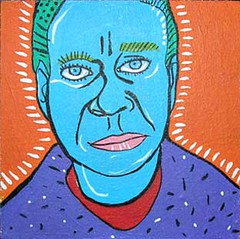 Portrait of Julia Kay for JKPP group
Portrait of Julia Kay for JKPP group
Z: ¿Cómo conociste el grupo JKPP? ¿Qué ha supuesto para ti? ¿Qué te aporta Internet, en general? How did you knew about JKPP group? What has been it for you? What gives Internet to you?
P: JKPP é um grupo de trocas artísticas e foi idealizado pela também artista plástica Julia Kay. É uma espaço para quem tem como afinidade o retrato e como desafio o outro. Já fiz cerca de 15 retratos de participantes deste grupo e fui retratada por vários integrantes. É divertido e acolhedor: fazer parte desta confraria nos torna um artista do mundo. Passei a me interessar por diversas culturas que os rostos desses meus companheiros carregam. JKPP também foi muito importante para que me descobrisse uma retratista. Até então não encarava as pessoas enquanto pintava, apenas retratava a lembrança das pessoas que passavam por mim. - JKPP es un grupo de intercambio artístico, creado por la también artista Julia Kay. Es un espacio para quienes tienen afinidad por el retrato y con el desafío que supone el otro. He hecho cerca de 15 retratos de los participantes y he sido retratada por varios miembros. Es divertido y acogedor: formar parte de esta fraternidad nos convierte en artistas del mundo. He empezado a interesarme por las diferentes culturas que reflejan las caras de mis compañeros. JKPP también ha sido muy importante para descubrirme como retratista. Hasta entonces no encaraba a las personas mientras pintaba, solo retrataba el recuerdo de la gente que pasaba por mí. - JKPP is a group of artistic exchange, created by artist Julia Kay. It is a space for those who have an affinity to the portrait and the other as a challenge. I've done about 15 portraits of participants in this group and have been portrayed by several members. It's fun and friendly: to belong to this brotherhood makes us world artists. I've became interested in different cultures that the faces of my fellow artists bear. JKPP has also been very important to discover myself as a portraitist. Until then, I didn't face people when I painted, I only depicted the memory of people who passed through me.
Z: Y para terminar: ¿"Patricia Brasil" es un pseudónimo, o es tu nombre real? Me gusta mucho porque es eufónico, identificativo y difícil de olvidar. And a last question: "Patrícia Brasil" is an artistic name, or is it your real name? I like it because it is euphonious, recognizable and difficult to forget.
P: Meu nome civil é Patrícia Lima. Em 2004 comecei a deixar minha produção em uma loja que se chama La Vereda, aqui em Santa Teresa onde moro. O lugar é muito visitado por turistas por isso assinava apenas Patricia – Brasil. Com o tempo suprimí o traço que me separava do meu país e adotei como nome artístico Patricia Brasil. - Mi nombre oficial es Patrícia Lima. En 2004 empecé a dejar mi producción en una tienda llamada La Vereda, aquí donde vivo, en Santa Teresa. Es un lugar muy visitado por turistas, por lo que sólo firmaba "Patrícia - Brasil". Con el tiempo suprimí el guión que me separaba de mi país y adopté como nombre artístico "Patrícia Brasil". - My legal name is Patrícia Lima. In 2004 I started leaving my production at a store called La Vereda, here where I live, in Santa Teresa. The place is visited by many tourists so I just signed as "Patrícia - Brasil". Later I suppressed the dash that separated me from my country and adopted as a stage name "Patrícia Brasil".
emaildapatriciabrasil@gmail.com
http://www.flickr.com/photos/patricia_brasil/
http://www.facebook.com/patricia.brasil.art
http://www.behance.net/gallery/Etnografia-Singela-Carioca-Rio-Natural-Ethnography/1253883
http://www.blurb.com/bookstore/detail/2048252
http://patriciabrasil.tumblr.com/
